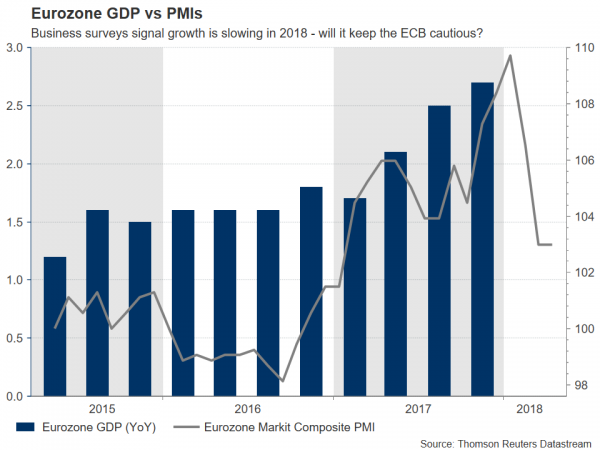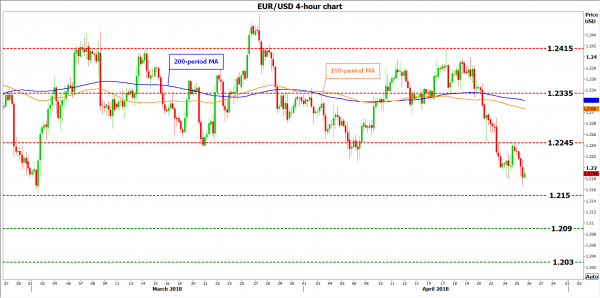The European Central Bank (ECB) will announce its policy decision on Thursday, at 1145 GMT. No change in either policy or guidance is expected, so price action in the euro will likely be dictated by the signals from President Draghi and other policymakers at the subsequent press conference, at 1230 GMT. Considering the softness in recent economic data, worries around protectionism and a firm euro, the balance of risks seems to be tilted towards a cautious tone by Draghi and Co.
At its latest meeting in March, the ECB took another small step towards normalizing policy, by removing from its forward guidance the so-called QE easing bias, the commitment that it stood ready to increase the size and/or duration of its asset purchases if the outlook became less favorable. Although President Draghi downplayed the importance of that move at the subsequent press conference, triggering a sharp drop in the euro, the removal of this dovish sentence was seen as paving the way for the Bank to end its QE program altogether later this year.
Alas, developments since then have been discouraging overall. In terms of economic data, inflation remains largely subdued, while economic growth appears to be slowing. The bloc’s core CPI rate has remained stuck at 1.0% since January, and while GDP data for Q1 have yet to be released, business surveys such as the PMIs suggest the economy is losing momentum, presenting downside risks to the ECB’s optimistic growth forecasts.
Moreover, the ECB appeared quite vigilant of global trade risks at its last meeting. The minutes showed concerns that protectionist measures could hinder growth, and that the risk of a full-blown trade conflict had risen. Considering that the latest US-China tariffs had not even been announced at that time, the ECB may view the risk of more trade frictions as having increased further, providing another reason to tread cautiously. Finally, the “strong” euro is likely to stay high on the Bank’s list of worries. While the currency traded mostly sideways this year, the Bank will likely remain watchful of any negative effects from the euro’s past appreciation, and will probably be keen to avoid fueling any further gains in the exchange rate.
All things considered, the Bank appears to have more incentives to strike a cautious tone, for now at least. President Draghi could adopt a conservative “wait-and-see” approach regarding further steps towards normalization, providing policymakers some time to monitor whether the latest economic slowdown is temporary, and how trade risks will evolve.
In case the ECB’s stance is seen as dovish overall, the euro could edge lower. Looking at euro/dollar, immediate support to declines could be found near the March 1 low of 1.2150, with steeper declines likely to bring the 1.2090 handle into play, the high of January 4. Further down, buy orders may be found near 1.2030, the September 20 peak.
On the other hand, if the Bank dismisses the recent economic slowdown as being owed to transitory factors, or if it downplays trade risks, the euro may soar. Resistance in euro/dollar may come around 1.2245, a level defined by the high of April 24. If the bulls overcome that hurdle, then sell orders may be found near 1.2335, the inside swing low of April 17, with even further advances likely to stall at 1.2415, the April 17 top.
In the big picture, even if the ECB does err on the side of caution at this meeting, that would still leave intact the broader narrative that the days of QE are drawing to an end. Policymakers still look set to begin scaling back their asset purchase program in the autumn, with some signaling of that likely to come in the summer meetings. For this narrative to be derailed, it would probably require a much sharper deterioration in economic data than what we have seen thus far, or for downside risks such as a trade war to materialize, both of which appear unlikely at this juncture.














